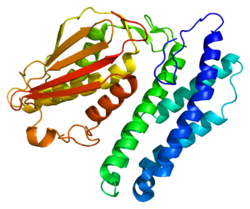Function
BCKDK regulates the activity of branched-chain α-ketoacid dehydrogenase complex (BCKD) through phosphorylation and inactivation. This inactivation results in increased branched-chain amino acids (BCAA), which is seen to reduce oxidative stress; however, having too much BCAA has been proven to be toxic to humans. Therefore, BCKDK is a vital tool to assist with BCAA homeostasis. [9] [10] As stated earlier, BCKDK concentrations vary depending on the type of tissue that is observed, whereas BCKD's concentration is the same in any tissue. Although BCKD concentration is constant, the amount of BCKDK determines the activity of the dehydrogenase complex. Since liver tissue is seen to have the lowest concentration of BCKDK, the activity of BCKD is seen to be the highest, delineating the fact that the BCKD kinase inversely affects the BCKD activity. [7]
Clinical significance
Abnormalities in BCKD activity often leads to pathological conditions which is why BCKDK is needed to regulate it. Often, mutations in the BCKDK gene occur creating the deviation in BCKD behavior. Exceedingly high BCKD complex activity increases branched-chain amino acid catabolism and protein degradation in skeletal muscle, which is a distinctive feature for cachexia. Deficiencies in BCKD activity have been the main cause in the rare metabolism maple syrup urine disease that can lead to mental retardation, brain edema, seizures, coma, and death if not treated correctly by lifelong limitation of branched-chain amino acid intake. [7] Because BCKDK regulates BCKD which in turn catalyzes BCAA, BCKDK is one of the factors that determines the concentration of BCAA levels. High BCAA levels can lead to insulin resistance and can be a potential marker for type 2 diabetes. [10] The amalgamation of BCAA can also lead to congenital heart diseases and heart failure. Furthermore, low levels of BCAA have been described as a cause of comorbid intellectual disability, autism, and epilepsy. [8] [11] [12]
Deficiency of BCKDK, first described in 2012, [13] is a disorder that could be considered as the "opposite" of maple syrup disease, because patients have decreased levels of branched-chain amino acids, instead of increased levels. The condition may present as autism with epileptiform abnormalities on EEG and seizures.
Therapeutics development
In 2023, Pfizer reported the development of the thiophene PF-07208254 as an allosteric BCKDK inhibitor that also promotes BCKDK degradation by promoting BCKDK interaction with BCKDH-E2. [14] A variant of this molecule, PF-07328948, was disclosed in 2024 and is being evaluated as a clinical candidate for heart failure. [15] [16]
This page is based on this
Wikipedia article Text is available under the
CC BY-SA 4.0 license; additional terms may apply.
Images, videos and audio are available under their respective licenses.








